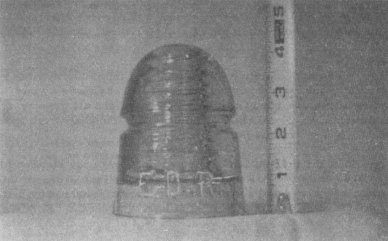CD145 E. D. R.
Reprinted from "INSULATORS - Crown Jewels of the Wire", December 1971, page 3
It's about time someone shed some light on the C. D. 145 insulator embossed
"E. D. R. ". Scattered references to it have surfaced occasionally,
most often misnaming it the "Edmonton-Dawson Railway" insulator.
Well. I dug a few last summer from the site of an old railway camp, have
researched the history of the line, and have even met some grand old timers who
remember it well enough to still call it the "Ever-Dangerous &
Badly-Constructed Railway".
The "Edmonton, Dunvegan & British Columbia Railway" (1907-1929)
was the company for whom the "E. D. R." insulators were made, and one
can only assume that the insulators were ordered before it was decided to extend
the line to connect with railways in British Columbia. Otherwise the embossing
would have been longer, as is the case with other Canadian insulators.

These insulators are scarce today (and Marion Milholland's 1972 suggested
price underscores this) due to an important project involving the U. S. Army
Corps of Engineers early in 1942.
The United States' entanglement in World War II was just a few months old,
and the need to connect the resources of Alaska via rail and highway to the
continental U. S. was obvious and immediate. Of the existing railways leading
toward Alaska, the E. D. R. line offered one critical segment from Edmonton,
Alberta, northwestward through terrain noted for numerous difficult river
crossings and deep muskeg. But this existing line was made of only 60 lb. rail, which wasn't strong
enough to withstand the use the U. S. Army had in mind. So their Corps of
Engineers, in conjunction with the Canadian National and the Canadian Pacific Railways, undertook the
enormous task of upgrading the line with the provision of heavier rail, higher
roadbed, and stronger trestles. The ubiquitous telegraph was upgraded with
heavier wire and with the new standard insulator of the day, the C. D. 154
"Dominion- 42".
The result of the completion of the project, including new construction of
perhaps a thousand miles of railway, was a year 'round rail line capable of
handling heavy freight all the way from the continental U. S. to Alaska, so that
construction of the famous Alaska Highway could begin.
The result of the completion of the project, from the standpoint of an
insulator collector, is that virtually all the insulators on this line today are
clear glass, with the occasional colour provided only by C. D. 145 Brookfield
"B"s. Where are all the "E. D. R."s? Well, they're probably
under about ten feet of good old Alberta muskeg.
Now if you're wondering what muskeg is, well, that's northern Canadian swamp
that probably has, in one area, a glass bottom!
Collectively yours,
Mr. and Mrs. R. M. Settle
"TELETIQUES"
| 